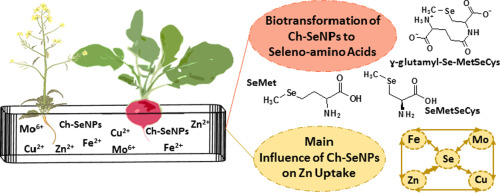当前位置:
X-MOL 学术
›
Sci. Total Environ.
›
论文详情
Our official English website, www.x-mol.net, welcomes your
feedback! (Note: you will need to create a separate account there.)
Insights into the accumulation and transformation of Ch-SeNPs by Raphanus sativus and Brassica juncea: Effect on essential elements uptake.
Science of the Total Environment ( IF 8.2 ) Pub Date : 2020-04-04 , DOI: 10.1016/j.scitotenv.2020.138453 Gustavo Moreno-Martín 1 , Jon Sanz-Landaluze 1 , María Eugenia León-González 1 , Yolanda Madrid 1
Science of the Total Environment ( IF 8.2 ) Pub Date : 2020-04-04 , DOI: 10.1016/j.scitotenv.2020.138453 Gustavo Moreno-Martín 1 , Jon Sanz-Landaluze 1 , María Eugenia León-González 1 , Yolanda Madrid 1
Affiliation

|
Selenium (Se) at very low doses has important functions for humans. Unfortunately, the low levels of Se in soils in various regions of the world have implemented the agronomic biofortification of crops by applying Se-enriched fertilizers (mainly based on selenate). Lately, the use of nanofertilizers is growing in interest as their low size reduces the amount of chemicals and minimizes nutrient losses in comparison with conventional bulk fertilizers. However, the knowledge on their fate and environmental impact is still scarce. This study aims to evaluate the biotransformation of chitosan-modified Se nanoparticles (Ch-SeNPs) as well as their effect on the metabolism of essential metals (Fe, Cu, Zn and Mo) when applied to hydroponic cultivation of R. sativus and B. juncea. In house-synthesized Ch-SeNPs were characterized in both synthesis and hydroponic culture media by transmission electron microscopy (TEM), dynamic light scattering (DLS) and nanoparticle tracking analysis (NTA). The composition of one-tenth strength Hoagland's solution did not affect the size, shape and concentration in number of particles per mL of Ch-SeNPs. The plants were grown inside a box at 25 °C during the months of May-July in 2018. After a week of treatment with Ch-SeNPs, plants were harvested and divided into roots and aerial part. The biotransformation of Ch-SeNPs was evaluated through a process of enzymatic hydrolysis and subsequent analysis by HPLC-ICP-MS and HPLC-ESI-MS/MS. The results confirmed the transformation of Ch-SeNPs to seleno-amino acids: Selenomethionine (SeMet), Semethylselenocysteine (SeMetSeCys) and ɣ-glutamyl-Se-MetSeCys. Moreover, Multiple-way analysis of variance (ANOVA) and principal component analysis (PCA) showed that, regardless the plant species, Ch-SeNPs supplementation affected the absorption of Zn.
中文翻译:

萝卜和芥菜对Ch-SeNPs积累和转化的见解:对基本元素吸收的影响。
极低剂量的硒(Se)对人类具有重要的功能。不幸的是,世界各地土壤中的硒含量低,已通过使用富含硒的肥料(主要基于硒酸盐)实现了农作物的农艺生物强化。近来,由于与传统的散装肥料相比,纳米肥料的尺寸小,可减少化学物质的用量并使养分流失最小化,因此人们对纳米肥料的使用日益受到关注。但是,关于它们的命运和环境影响的知识仍然很少。这项研究旨在评估壳聚糖修饰的Se纳米颗粒(Ch-SeNPs)的生物转化以及它们对水生栽培的R. sativus和B进行的对必需金属(Fe,Cu,Zn和Mo)代谢的影响。 juncea。在室内合成的Ch-SeNPs可以通过透射电子显微镜(TEM),动态光散射(DLS)和纳米粒子跟踪分析(NTA)在合成培养基和水培培养基中进行表征。强度为十分之一的霍格兰溶液的组成不会影响每毫升Ch-SeNPs的大小,形状和浓度。在2018年5月至7月的几个月中,植物在25°C的盒子中生长。用Ch-SeNPs处理一周后,收获植物,分为根和地上部分。Ch-SeNPs的生物转化通过酶促水解过程进行评估,然后通过HPLC-ICP-MS和HPLC-ESI-MS / MS进行分析。结果证实了Ch-SeNPs向硒氨基酸的转化:硒蛋氨酸(SeMet),硒甲基硒代半胱氨酸(SeMetSeCys)和β-谷氨酰基-Se-MetSeCys。此外,方差多路分析(ANOVA)和主成分分析(PCA)表明,无论植物种类如何,Ch-SeNPs的添加都会影响锌的吸收。
更新日期:2020-04-06
中文翻译:

萝卜和芥菜对Ch-SeNPs积累和转化的见解:对基本元素吸收的影响。
极低剂量的硒(Se)对人类具有重要的功能。不幸的是,世界各地土壤中的硒含量低,已通过使用富含硒的肥料(主要基于硒酸盐)实现了农作物的农艺生物强化。近来,由于与传统的散装肥料相比,纳米肥料的尺寸小,可减少化学物质的用量并使养分流失最小化,因此人们对纳米肥料的使用日益受到关注。但是,关于它们的命运和环境影响的知识仍然很少。这项研究旨在评估壳聚糖修饰的Se纳米颗粒(Ch-SeNPs)的生物转化以及它们对水生栽培的R. sativus和B进行的对必需金属(Fe,Cu,Zn和Mo)代谢的影响。 juncea。在室内合成的Ch-SeNPs可以通过透射电子显微镜(TEM),动态光散射(DLS)和纳米粒子跟踪分析(NTA)在合成培养基和水培培养基中进行表征。强度为十分之一的霍格兰溶液的组成不会影响每毫升Ch-SeNPs的大小,形状和浓度。在2018年5月至7月的几个月中,植物在25°C的盒子中生长。用Ch-SeNPs处理一周后,收获植物,分为根和地上部分。Ch-SeNPs的生物转化通过酶促水解过程进行评估,然后通过HPLC-ICP-MS和HPLC-ESI-MS / MS进行分析。结果证实了Ch-SeNPs向硒氨基酸的转化:硒蛋氨酸(SeMet),硒甲基硒代半胱氨酸(SeMetSeCys)和β-谷氨酰基-Se-MetSeCys。此外,方差多路分析(ANOVA)和主成分分析(PCA)表明,无论植物种类如何,Ch-SeNPs的添加都会影响锌的吸收。











































 京公网安备 11010802027423号
京公网安备 11010802027423号